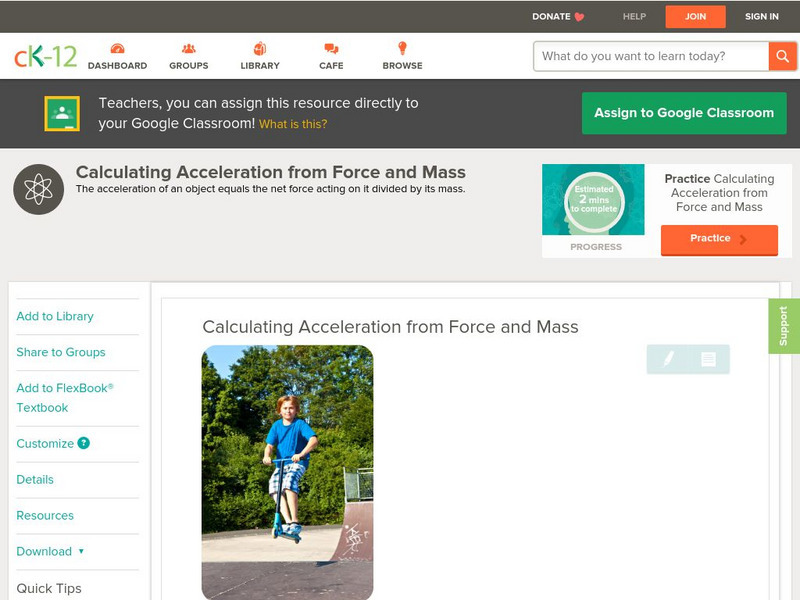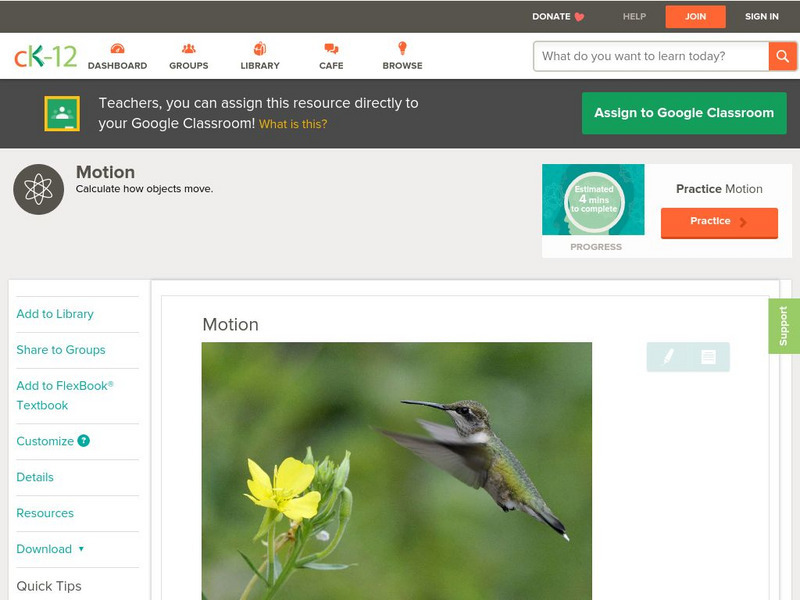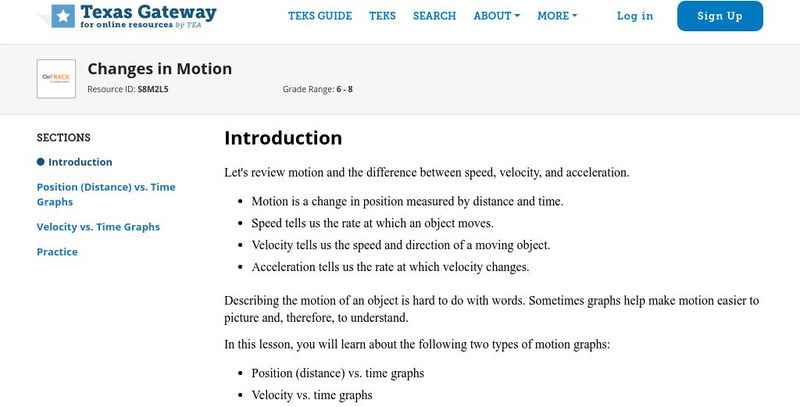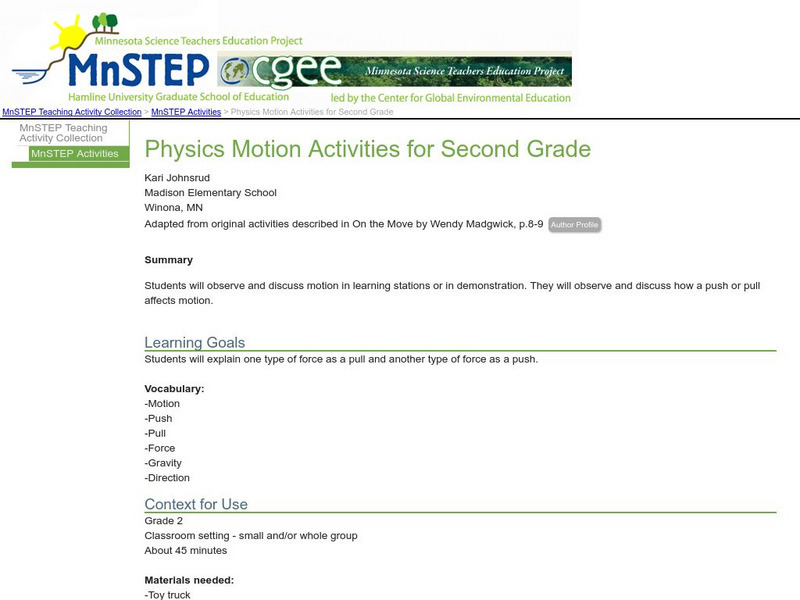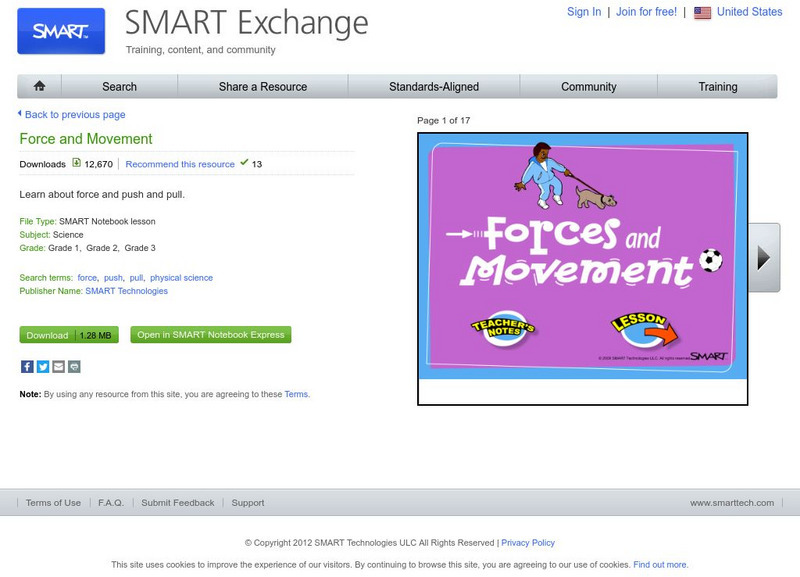Physics Classroom
The Physics Classroom: Vectors Motion and Forces in Two Dimensions
Three complete tutorials on vectors and two dimension forces and motion. Lessons include informational text, interactive activities, animations, and quick, interactive comprehension checks along the way.
TeachEngineering
Teach Engineering: Energy of Motion
By taking a look at the energy of motion all around us, students learn about the types of energy and their characteristics. They first learn about the two simplest forms of mechanical energy: kinetic and potential energy, as illustrated...
Better Lesson
Better Lesson: Force and Motion Investigation
Conduct an investigation collaboratively on the effect of force applied on an object to produce data to serve as the basis for evidence, by using fair tests in which variables are controlled and the number of trials are considered.
CK-12 Foundation
Ck 12: Physical Science: Calculating Acceleration From Force and Mass
[Free Registration/Login may be required to access all resource tools.] How to calculate acceleration from force and mass, and force from mass and acceleration.
CK-12 Foundation
Ck 12: Physical Science: Motion
[Free Registration/Login may be required to access all resource tools.] Definition of motion and how it is related to frame of reference.
Physics Classroom
The Physics Classroom: Motion of a Mass on a Spring
This tutorial investigates the motion of a mass on a spring and how a variety of quantities change over the course of time. Such quantities will include forces, position, velocity and energy - both kinetic and potential energy. Take the...
Physics Classroom
The Physics Classroom: Vibrational Motion
In this article the concept of vibrational motion and its relationship to waves is introduced.
Physics Classroom
The Physics Classroom: Circular and Satellite Motion: Athletics
Students investigate a variety of applications of circular motion principles to the world of sports, and use Newton's laws to mathematically analyze such motions. The emphasis will not be upon an investigation of the details of every...
Texas Education Agency
Texas Gateway: Changes in Motion
In this lesson, you will learn about position vs. time graphs and velocity vs. time graphs and how to use them to solve problems.
ClassFlow
Class Flow: Forces in Motion
[Free Registration/Login Required] This lesson explores forces, and how they react to the world around us. It also discusses Newton's Laws of Science.
Physics Classroom
The Physics Classroom: Describing Motion With Words
This lesson from the Glenbrook South High School gives a nice review and detailed explanation of velocity, speed, distance, displacement, and acceleration. A good introduction to the "language of Kinematics."
Science Education Resource Center at Carleton College
Serc: Physics Motion Activities for Second Grade
A lesson plan for stations that allow students to explore how a push or pull affects motion.
SMART Technologies
Smart: Force and Movement
Learn how pushes and pulls relate to theconcept of force and motion.
Khan Academy
Khan Academy: Activity: Frictional Force Experiment
A lesson about friction can be found on this website. Students will experiment to see how motion and frictional force affect the game of football.
TED Talks
Ted: Ted Ed: Would You Weigh Less in an Elevator?
Video that uses an elevator in motion to describe the relationship among weight, gravity, and relative motion. [3:36] Includes a short quiz and a list of additional resources to explore.
NC State University
The Engineering Place: Roller Coasters [Pdf]
A lesson where students construct a roller coaster and test it under different conditions to learn about force and motion.
SMART Technologies
Smart: Science Choice Board Newton's Laws of Motion
Students level up learning by completing Newton's Laws of Motion task cards including all levels of Bloom's taxonomy.
Physics Classroom
The Physics Classroom: Circular and Satellite Motion: Centripetal Force
Through illustrated examples and practice problems, students explore the centripetal force requirement. So for an object moving in a circle, there must be an inward force acting upon it in order to cause its inward acceleration.
Physics Classroom
The Physics Classroom: Motion/forces in Two Dimensions: Projectile's Trajectory
This illustrated tutorial discusses the horizontal and vertical components of a projectile's motion; specific attention will be given to the presence/absence of forces, accelerations, and velocity.
Physics Classroom
The Physics Classroom: Motion/forces in Two Dimensions: Perpendicular Components
This physics tutorial provides students illustrated examples and interactive practice problems containing perpendicular components of motion.
Physics Classroom
The Physics Classroom: Motion and Forces in Two Dimensions: What Is a Projectile
Students apply both kinematic principles and Newton's laws of motion to understand and explain the motion of objects moving in two dimensions, more specifically, the motion of projectiles.
Physics Classroom
The Physics Classroom: Circular and Satellite Motion:circular Motion Mathematics
Using the values of speed, acceleration, and force, students explore and analyze the motion of objects in circles.
Physics Classroom
The Physics Classroom: Pendulum Motion
This tutorial investigates pendulum motion and how a variety of quantities change over the course of time. Such quantities will include forces, position, velocity and energy - both kinetic and potential energy. Take the interactive...
Physics Classroom
The Physics Classroom: Circular and Satellite Motion: Principles for Satellites
Students explore how a satellite's motion is governed by the same physics principles and described by the same mathematical equations.


